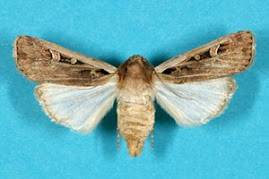For the most part, crops in the county are looking pretty good. We could use a shot of rain though.
There are several fields that never fully recovered from the spring/early summer flooding and water damage - but things are looking good compared to what I'm hearing and seeing in other parts of the state.
All field corn is either tasseling or will be in the next few days. I haven't found any Western Bean Cutworm moths in my trap yet - a few European Corn Borers, but now WBC.
Soybeans are really starting to fill in - and some are blooming. Last week I put out the First Year Western Corn Rootworm traps in a couple of bean fields - will check them on Friday for the first time.
Alfalfa throughout the county is looking very good. There's been a lot of second cuttings last week and the week before. Some questions are coming in about spraying for potato leaf hopper.
We're not a huge wheat-producing county, but the wheat we did produce has been harvested.
Tuesday, July 29, 2008
Monday, July 21, 2008
Coming right along...
When I came back from North Carolina I was pleasantly surprised to see a good bit of corn tasseling. After this weekend, I'd guess that about 25 to 30% is now tasseling. A good bit of corn I saw that was under water or damaged by water a few weeks ago has popped back and is doing fine - in some places.
Hay production in Coshocton County is pretty strong. Although some producers didn't get to their first cutting last week, there are others wrapping up their second cutting.
Soybeans are looking good right now too. They are in a variety of growth stages - but fields that had yellowish spots in them are greening up.
This week I'm putting traps in two county soybean fields to track western corn rootworm. They'll both be in the north central part of the county.
No activity in the Western Bean Cutworm trap yet.
Hay production in Coshocton County is pretty strong. Although some producers didn't get to their first cutting last week, there are others wrapping up their second cutting.
Soybeans are looking good right now too. They are in a variety of growth stages - but fields that had yellowish spots in them are greening up.
This week I'm putting traps in two county soybean fields to track western corn rootworm. They'll both be in the north central part of the county.
No activity in the Western Bean Cutworm trap yet.
Thursday, July 10, 2008
Weather-damaged crops
The recent 3+ inches of rain that fell on Coshocton County Monday evening/night had a pretty big impact on some area fields. Corn, soybean, and wheat fields in the county have all been impacted by the rain and flooding conditions. Driving around the county last night, I saw a couple of completely lost bean fields (small ones) and one large wheat field (partially harvested) with substantial rain/wind damage.
The fields with severe damage are not in the majority, but many do have minimal weather-related damage.
The fields with severe damage are not in the majority, but many do have minimal weather-related damage.
Tuesday, July 8, 2008
Sunshine, Rain, Sunshine, Rain Pattern Continues
Jim Noel with the National Weather Service predicts an up and down weather week is expected. It will be hot and humid early in the week with storms followed by cooler and drier weather for the second half of the week.
The rain gauge at my house collected about 1/2 of rain from late last week through the weekend. Despite some water still laying in fields, corn across the county is looking pretty good. There are a couple of fields that are about four inches tall and the most mature fields I've seen are a good 10 days away from tassel. Like most parts of the state, wheat harvest hasn't started - but some farmers have gotten their second hay cuttings already this week...
I have yet to find a Western Bean Cutworm in the trap I set in the western part of the county. The European Corn Borer trap continues to attract these pests...
The rain gauge at my house collected about 1/2 of rain from late last week through the weekend. Despite some water still laying in fields, corn across the county is looking pretty good. There are a couple of fields that are about four inches tall and the most mature fields I've seen are a good 10 days away from tassel. Like most parts of the state, wheat harvest hasn't started - but some farmers have gotten their second hay cuttings already this week...
I have yet to find a Western Bean Cutworm in the trap I set in the western part of the county. The European Corn Borer trap continues to attract these pests...
Wednesday, July 2, 2008
Soybean Aphid Update
We made numerous visits to soybean fields in northern Ohio last week to determine the current status of the soybean aphid. No aphids were found in any of the visited fields. Furthermore, no aphids have been found in any of the soybean rust sentinel plots. Although we did not sample every field in Ohio, we feel save in saying aphids are either non-existent or very low in Ohio at this time. Although aphids have been found in other states, their numbers have also been low for the most part.
We still feel a combination of low aphid overwintering plus numerous beneficial insects are combining to keep aphids at low numbers. As always, we will keep an eye on the situation throughout July to see what happens because things could quickly change. Keep checking this CORN newsletter for further updates on the aphid.
A concern we have at this time, which might be more critical because of the current weed situation in a lot of fields, is the inclination for some growers who might want to “help” the situation by adding a “preventive” insecticide treatment in their late herbicide applications. We highly recommend NOT doing this! There are only two things that can or might happen. The first is you will waste money! The aphid densities are too low or non-existent in most fields. There is absolutely no reason to be treating them at this time, preventively or not. Second, because beneficial insects might be helping to keep aphid populations down, an insecticide treatment would only serve to kill off those beneficials, perhaps allowing the few aphids that might remain in a field to start multiplying easier in the coming weeks. We urge you to allow the beneficial insects to do their job by helping to keep soybean aphid below economic levels. Remember: IPM!
by: Ron Hammond, Andy Michel, Bruce Eisley
MM comment: hopefully you've all got soybean aphids on our scouting list...please let me know if you find any aphids, European Corn Borer, Western Bean Cutworm, or any other insects or diseases impacting your crops.
We still feel a combination of low aphid overwintering plus numerous beneficial insects are combining to keep aphids at low numbers. As always, we will keep an eye on the situation throughout July to see what happens because things could quickly change. Keep checking this CORN newsletter for further updates on the aphid.
A concern we have at this time, which might be more critical because of the current weed situation in a lot of fields, is the inclination for some growers who might want to “help” the situation by adding a “preventive” insecticide treatment in their late herbicide applications. We highly recommend NOT doing this! There are only two things that can or might happen. The first is you will waste money! The aphid densities are too low or non-existent in most fields. There is absolutely no reason to be treating them at this time, preventively or not. Second, because beneficial insects might be helping to keep aphid populations down, an insecticide treatment would only serve to kill off those beneficials, perhaps allowing the few aphids that might remain in a field to start multiplying easier in the coming weeks. We urge you to allow the beneficial insects to do their job by helping to keep soybean aphid below economic levels. Remember: IPM!
by: Ron Hammond, Andy Michel, Bruce Eisley
MM comment: hopefully you've all got soybean aphids on our scouting list...please let me know if you find any aphids, European Corn Borer, Western Bean Cutworm, or any other insects or diseases impacting your crops.
Subscribe to:
Comments (Atom)




